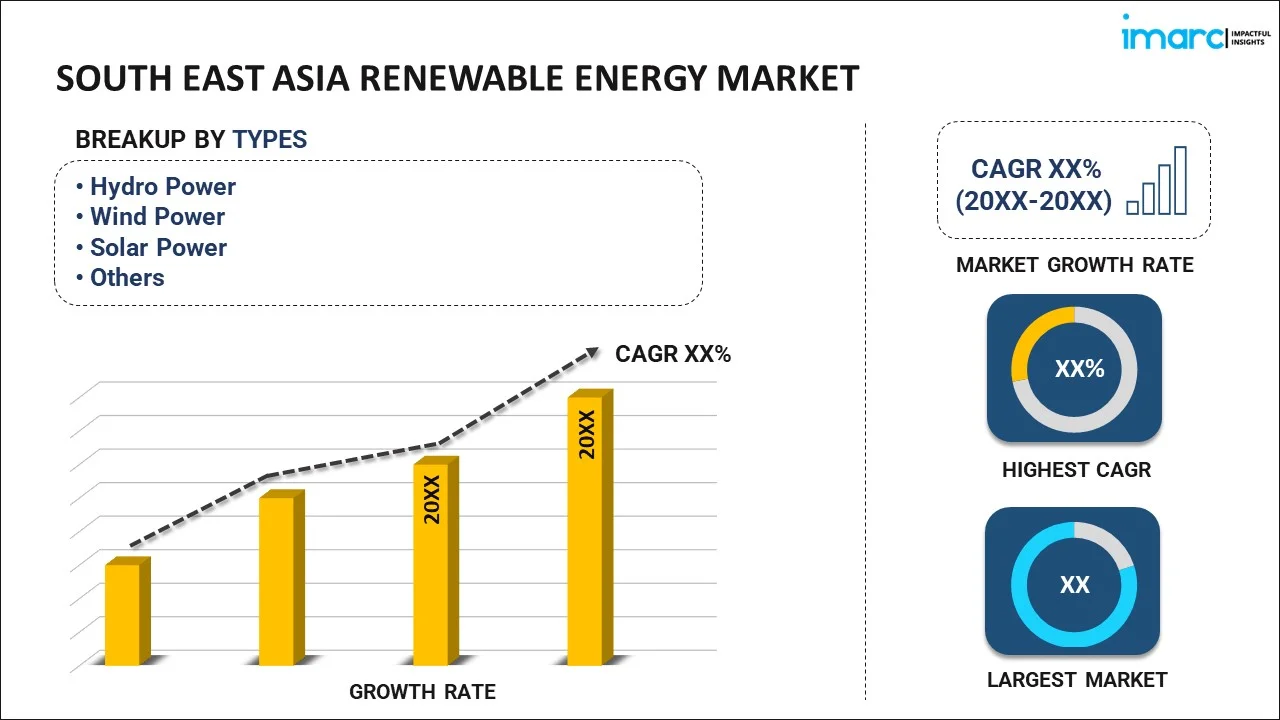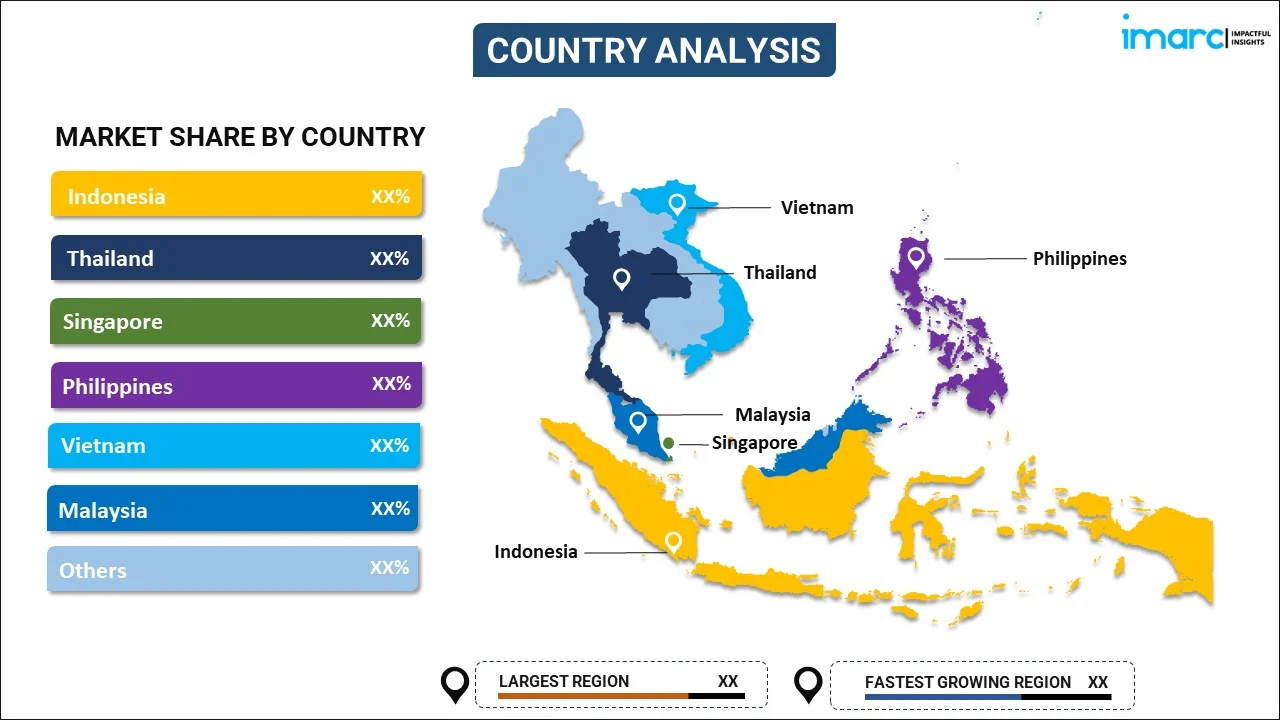
South East Asia Renewable Energy Market Report by Type (Hydro Power, Wind Power, Solar Power, Bioenergy, and Others), End User (Industrial, Residential, Commercial), and Country 2025-2033
Market Overview:
South East Asia renewable energy market size is projected to exhibit a growth rate (CAGR) of 7.22% during 2025-2033. The increasing advances in grid technologies that facilitate the integration of renewable energy sources into existing power grids, are driving the market.
|
Report Attribute
|
Key Statistics
|
|---|---|
|
Base Year
|
2024 |
|
Forecast Years
|
2025-2033
|
|
Historical Years
|
2019-2024
|
| Market Growth Rate (2025-2033) | 7.22% |
Renewable energy refers to sustainable and environmentally friendly sources of power that are naturally replenished. Unlike finite fossil fuels, renewable energy harnesses resources that are abundant and continuously available, contributing to a cleaner and more sustainable energy future. Common types of renewable energy include solar power, generated by capturing sunlight using photovoltaic cells or solar thermal systems; wind energy, derived from the kinetic energy of moving air; hydropower, utilizing the gravitational force of flowing water; geothermal energy, tapping into the Earth's internal heat; and biomass energy, produced from organic materials like plants and waste. Embracing these renewable sources helps reduce greenhouse gas emissions, combat climate change, and enhance energy security. As technology advances, the cost-effectiveness and efficiency of renewable energy continue to improve, making it an integral part of efforts to transition towards a more sustainable and resilient energy landscape.
South East Asia Renewable Energy Market Trends:
The renewable energy market in South East Asia is experiencing unprecedented growth, primarily driven by several key factors. Firstly, heightened awareness of climate change and environmental degradation has led governments to implement stringent regulations favoring cleaner energy sources. Consequently, these regulatory initiatives have spurred increased investments in renewable technologies. Moreover, advancements in technology have significantly reduced the costs associated with renewable energy production, making it a more attractive and economically viable option. In addition to regulatory and technological drivers, a growing regional commitment to sustainability has prompted businesses and consumers alike to prioritize renewable energy sources. The shift towards corporate social responsibility and a desire for energy independence has led companies to invest heavily in renewable projects, further fueling market expansion. Simultaneously, the increasing availability and efficiency of energy storage solutions have addressed one of the primary challenges associated with renewables, namely intermittent power generation. In summary, the renewable energy market in South East Asia is thriving due to a confluence of regulatory support, technological innovation, corporate sustainability initiatives, and the growing realization of the environmental and economic benefits of transitioning towards cleaner energy alternatives.
South East Asia Renewable Energy Market Segmentation:
IMARC Group provides an analysis of the key trends in each segment of the market, along with forecasts at the regional and country levels for 2025-2033. Our report has categorized the market based on type and end user.
Type Insights:

- Hydro Power
- Wind Power
- Solar Power
- Bioenergy
- Others
The report has provided a detailed breakup and analysis of the market based on the type. This includes hydro power, wind power, solar power, bioenergy, and others.
End User Insights:
- Industrial
- Residential
- Commercial
A detailed breakup and analysis of the market based on the end user have also been provided in the report. This includes industrial, residential, and commercial.
Country Insights:

- Indonesia
- Thailand
- Singapore
- Philippines
- Vietnam
- Malaysia
- Others
The report has also provided a comprehensive analysis of all the major regional markets, which include Indonesia, Thailand, Singapore, Philippines, Vietnam, Malaysia, and Others.
Competitive Landscape:
The market research report has also provided a comprehensive analysis of the competitive landscape in the market. Competitive analysis such as market structure, key player positioning, top winning strategies, competitive dashboard, and company evaluation quadrant has been covered in the report. Also, detailed profiles of all major companies have been provided. Some of the key players include:
- B.Grimm Group
- BCPG Public Company Limited (Bangchak Corporation)
- Gulf Energy Development Public Company Limited
- San Miguel Corporation
- Sindicatum Sustainable Resources Pte. Limited
- Trina Solar Co., Ltd.
- TTC GROUP
(Please note that this is only a partial list of the key players, and the complete list is provided in the report.)
South East Asia Renewable Energy Market Report Coverage:
| Report Features | Details |
|---|---|
| Base Year of the Analysis | 2024 |
| Historical Period | 2019-2024 |
| Forecast Period | 2025-2033 |
| Units | Million USD |
| Scope of the Report | Exploration of Historical and Forecast Trends, Industry Catalysts and Challenges, Segment-Wise Historical and Predictive Market Assessment:
|
| Types Covered | Hydro Power, Wind Power, Solar Power, Bioenergy, Others |
| End Users Covered | Industrial, Residential, Commercial |
| Countries Covered | Indonesia, Thailand, Singapore, Philippines, Vietnam, Malaysia, Others |
| Companies Covered | B.Grimm Group, BCPG Public Company Limited (Bangchak Corporation), Gulf Energy Development Public Company Limited, San Miguel Corporation, Sindicatum Sustainable Resources Pte. Limited, Trina Solar Co., Ltd., TTC GROUP, etc. |
| Customization Scope | 10% Free Customization |
| Post-Sale Analyst Support | 10-12 Weeks |
| Delivery Format | PDF and Excel through Email (We can also provide the editable version of the report in PPT/Word format on special request) |
Key Questions Answered in This Report:
- How has the South East Asia renewable energy market performed so far and how will it perform in the coming years?
- What has been the impact of COVID-19 on the South East Asia renewable energy market?
- What is the breakup of the South East Asia renewable energy market on the basis of type?
- What is the breakup of the South East Asia renewable energy market on the basis of end user?
- What are the various stages in the value chain of the South East Asia renewable energy market?
- What are the key driving factors and challenges in the South East Asia renewable energy?
- What is the structure of the South East Asia renewable energy market and who are the key players?
- What is the degree of competition in the South East Asia renewable energy market?
Key Benefits for Stakeholders:
- IMARC’s industry report offers a comprehensive quantitative analysis of various market segments, historical and current market trends, market forecasts, and dynamics of the South East Asia renewable energy market from 2019-2033.
- The research report provides the latest information on the market drivers, challenges, and opportunities in the South East Asia renewable energy market.
- Porter's five forces analysis assist stakeholders in assessing the impact of new entrants, competitive rivalry, supplier power, buyer power, and the threat of substitution. It helps stakeholders to analyze the level of competition within the South East Asia renewable energy industry and its attractiveness.
- Competitive landscape allows stakeholders to understand their competitive environment and provides an insight into the current positions of key players in the market.
Need more help?
- Speak to our experienced analysts for insights on the current market scenarios.
- Include additional segments and countries to customize the report as per your requirement.
- Gain an unparalleled competitive advantage in your domain by understanding how to utilize the report and positively impacting your operations and revenue.
- For further assistance, please connect with our analysts.
 Inquire Before Buying
Inquire Before Buying
 Speak to an Analyst
Speak to an Analyst
 Request Brochure
Request Brochure
 Request Customization
Request Customization




.webp)




.webp)












